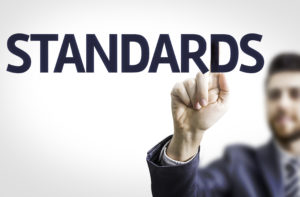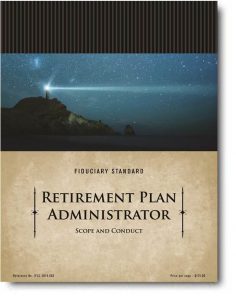
A published set of uniformly enforced guidelines and specifications is the essential trait of a standard. Examples of published standards abound in many fields including technology, manufacturing, and healthcare. A ton of commentary has appeared in the retirement plan industry’s media and social networking channels recently regarding the so-called “fiduciary” standard.
The Employee Retirement Income Security Act (“ERISA”), which establishes fiduciary status for organizations and individuals that exert control over certain employee benefit plans, is repeatedly referenced by commentators and vendors as the place where the fiduciary standard dwells.
Principles without Practices
At best, ERISA defines the fiduciary principles that comprise how a board of directors, CFO, or human resource executive should act. Those key principles include loyalty beyond all others to an ERISA plan, independence (no conflicts of interest), and exclusive purpose (don’t leverage a plan’s assets for personal or corporate use).
Overarching ERISA’s fiduciary principles is its demand for prudence in decision making. ERISA does not, however, define the steps or practices needed to give life to the principles.
Standards Energize Principles
There are over 50 major global organizations in existence that develop and maintain standards. Collectively, they publish exact criteria for how products are made, services are distributed, and vendors are tested. None of them publish an ERISA fiduciary standard. Incidentally, the U.S. Department of Labor that enforces ERISA is not listed among them.
Standards promote a culture of continual improvement. Since businesses today simply can’t afford to take an improvised, reactive approach to risk standards help executives identify risks and minimize them.
The Non-Standard Standard
Executives that manage welfare benefit and retirement plans, however, are left in the cold. That’s because ERISA does not contain any specific steps on how to fulfill its fiduciary principles.
It’s not surprising that surveys of CFOs and human resource executives consistently reveal their unease at being asked to assume a personal liability for their ERISA plans. Labeling ERISA’s outline of fiduciary principles a standard is inaccurate and misleading. By comparison with criteria and specifications published by global standards bodies, the so-called fiduciary standard is not a standard at all.
More Trouble Coming
Vendors of services to ERISA plans, supported by their member driven associations, continue to characterize ERISA’s fiduciary expectations in investment centric terms. There is now overwhelming evidence from lawsuits against plan fiduciaries and fines levied against scores of employers that there is a lot more to satisfying ERISA’s unwritten fiduciary standard than picking mutual funds for a 401(k) plan lineup.
The combination of multiple employee benefit plans for health, welfare, retirement and work place safety each one subject to separate complex federal laws (e.g., ERISA, HIPPA, OSH Act, and ACA) can easily conceal from boards of directors and operating unit executives personal risks like those fostered by ERISA.
Legal trouble for employers and the executives that manage their employer’s ERISA plans is on the rise and will continue…unless prudence is evidenced in a record of their behavior guided by a comprehensive standard. Where standards are lacking, chaos results.
Here’s a Valuable Resource
Retirement Plan Administrator: Scope and Conduct is a guide book that defines specific criteria for all four skill areas required to fulfill ERISA’s fiduciary principles.





